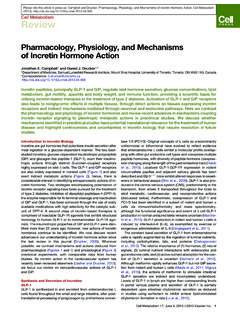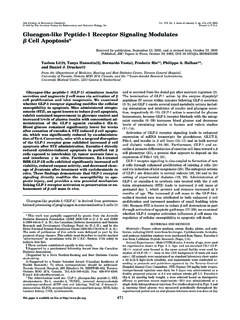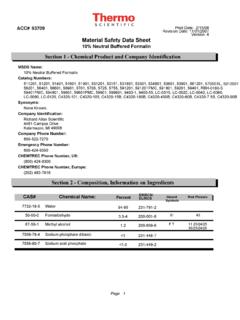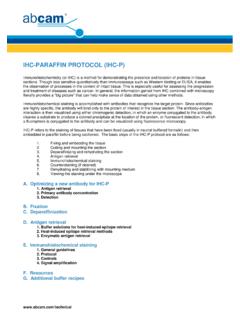Transcription of Human glucagon gene promoter sequences …
1 Human glucagon gene promoter sequences regulatingtissue-specific versus nutrient-regulated gene expressionMIN NIAN,1 JUN GU,1 DAVID M. IRWIN,1 AND DANIEL J. DRUCKER1,2 Departments of1 Laboratory Medicine and Pathobiology and2 Medicine, Banting and BestDiabetes Centre, Toronto General Hospital, University of Toronto, Toronto, Canada M5G 2C4 Received 10 April 2001; accepted in final form 31 August 2001 Nian, Min, Jun Gu, David M. Irwin, and Daniel glucagon gene promoter sequences regu-lating tissue -specific versus nutrient-regulated gene J Physiol Regulatory Integrative Comp Physiol282:R173 R183, 2002; The gluca-gon-like peptides (GLPs) are synthesized and secreted in anutrient-dependent manner in rodents; however, the factorsregulating Human GLP-1 and GLP-2 biosynthesis remainunclear.
2 To understand how nutrients regulate Human pro- glucagon gene expression, we studied the expression of ahuman proglucagon promoter -growth hormone (GH) trans- gene in Human glucagon -GH transgenic mice. Fasting-refeeding significantly decreased and increased the levels ofcirculating mouse insulin and transgene-derived hGH (P fasting vs. refeeding) and decreased and upregulated,respectively, the levels of endogenous mouse proglucagonRNA in the ileum but not in the jejunum or colon. High-fiberfeeding significantly increased the levels of glucose-stimu-lated circulating hGH and upregulated levels of mouse intes-tinal proglucagon gene expression in the jejunum, ileum, andcolon (P , 0 vs.)
3 30% fiber diet). In contrast, neitherfasting-refeeding nor a high-fiber diet upregulated the ex-pression of the Human proglucagon promoter -hGH trans- gene . These findings demonstrate that Human proglucagongene regulatory sequences specifying tissue -specific expres-sion in gut endocrine cells are not sufficient for recognition ofenergy-derived signals regulating murine glucagon gene ex-pression in enteroendocrine cells in ; gut; glucagon -like peptide 1; glucagon -like pep-tide 2; dietTHE MAMMALIAN PROGLUCAGON gene is expressed in the -cells of pancreatic islets, enteroendocrine L cells ofthe small and large intestine, and neuronal cell bodiesin the brain stem (14, 26).
4 tissue -specific posttransla-tional processing of proglucagon results in the libera-tion of a distinct profile of proglucagon-derived pep-tides (PGDPs) in each tissue . Whereas 29-amino acidglucagon is the principal bioactive PGDP generated inthe pancreas, glicentin, oxyntomodulin, and two gluca-gon-like peptides (GLP), GLP-1 and GLP-2, are pro-duced in the intestine and central nervous system (13).The actions of the PGDPs converge on the regulationof nutrient assimilation and energy homeostasis. Glu-cagon is released from islet -cells in response to adecrease in blood glucose and promotes restoration ofcirculating blood glucose via effects on hepatic glyco-genolysis and gluconeogenesis in both normal subjectsand in patients with diabetes (12).
5 GLP-1 is a potentglucose-dependent insulinotropic hormone that regu-lates nutrient intake and disposal via effects on feedingbehavior, gastrointestinal motility, and stimulationand inhibition of insulin and glucagon secretion, re-spectively (13, 21). GLP-2 acts more proximally in thecontrol of energy absorption via effects on gastric emp-tying (43), intestinal hexose transport (10), mucosalbarrier function (3), and both proliferation and apoptosisin the gastrointestinal epithelium (13, 15, 42).The therapeutic potential of the intestinal PGDPs,specifically GLP-1 and GLP-2 for the treatment ofdiabetes and intestinal diseases, has engendered con-siderable interest in the mechanisms regulating con-trol of intestinal PGDP synthesis and secretion.
6 Nutri-ents, vagal nerve innervation, and peptide hormonesconstitute key components of the physiological circuitsregulating PGDP secretion from rodent and humanenteroendocrine L cells (23, 33 36, 44). Of these fac-tors, nutrients consistently stimulate secretion ofPGDPs from both rodent and Human intestinal L cells;however, the intracellular signaling mechanisms thatmediate endocrine cell recognition of luminal nutrientcontent remain poorly understood (8).Although nutrients upregulate the levels of proglu-cagon mRNA transcripts in specific regions of the ratgastrointestinal tract, the molecular factors regulatingintestinal proglucagon gene transcription in the basaland nutrient-stimulated state remain poorly under-stood.
7 Furthermore, the majority of studies examiningthe control of proglucagon gene expression have fo-cused on analysis of the rodent proglucagon gene pro-moter (29). Although rat proglucagon gene 5 -flankingsequences that target reporter gene expression to en-teroendocrine L cells in mice have been identified (24),the pathways and molecules coupling nutrient intaketo activation of intestinal proglucagon gene expressionhave not been elucidated. Furthermore, even less isknown about the regulation of Human proglucagonAddress for reprint requests and other correspondence: D. , Toronto General Hospital, 200 Elizabeth St., Toronto, On-tario, Canada M5G 2C4 (E-mail: costs of publication of this article were defrayed in part by thepayment of page charges.)
8 The article must therefore be herebymarked advertisement in accordance with 18 Section 1734solely to indicate this J Physiol Regulatory Integrative Comp Physiol282: R173 R183, 2002; $ Copyright 2002 the American Physiological expression in the basal and understand the mechanisms regulating humanGLP-1 and GLP-2 biosynthesis, we initiated studiesdirected at characterizing mechanisms important forregulation of Human proglucagon gene expression. Re-markably, although the Human and rat proglucagongene promoters exhibit significant sequence conserva-tion and identity within the proximal 5 -untranslatedand 5 -flanking region (20, 27), the activities of the ratand Human promoters exhibit significant functionaldivergence after transfection of islet and intestinal celllines in vitro and in analysis of tissue -specific expres-sion patterns in transgenic mice in vivo (27).
9 These observations emphasize that the DNA se-quences and transcription factors regulating expres-sion of the rat proglucagon gene promoter may not bedirectly applicable to understanding the transcrip-tional control of Human proglucagon gene , the lack of Human intestinal endocrine celllines that produce Human GLP-1 and GLP-2 furthercomplicates efforts focused on studies of Human pro- glucagon gene transcription. As afirst step toward theanalysis of Human proglucagon gene expression in dif-ferentiated enteroendocrine cells, we generated hu-man glucagon -growth hormone (hGLU-GH) transgenicmice that express the hGH reporter gene under thecontrol of Human proglucagon gene 5 -flanking se-quences.
10 These mice express hGH mRNA transcriptsin the gastrointestinal tract, with hGH immunoreac-tivity localized to enteroendocrine L cells in the epithe-lial mucosa (27). To identify factors regulating thephysiological control of Human proglucagon gene tran-scription, we have now studied the expression of boththe endogenous murine proglucagon gene and the hGHtransgene after manipulation of the nutrient content ofthe murine gastrointestinal tract in AND and chemicals were purchased fromBioshop Canada (Burlington, Ontario, Canada), Caledon(Georgetown, Ontario, Canada), Difco Laboratories (Detroit,MI), Pharmacia (Baie d Urfe, Quebec, Canada), Sigma Chem-ical (St.)







